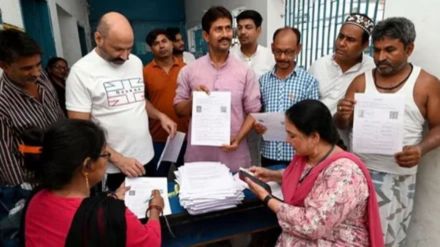The Bihar Special Intensive Revision (SIR) data, as shared by the Election Commission of India (ECI) on September 30, shows an overall deletion of 47 lakh names from the list. The new voter roll has 7.42 crore names, less than what was there on June 24. This is after addition of eligible voters and deletion of non-eligible ones. One fact is clear that in all the 38 districts, the numbers of voters has reduced and three districts lead the chart – Gopalganj, Kishanganj and Purnia.
The other thing common across all the is that the draft SIR roll on August 1 and the final one has a slight level of increase in the number of voters.
Furthermore, the deletion data shows that hardly any removal has taken place on the basis of failure to prove citizenship, which raises questions as the entire controversy was around weeding out “illegal immigrants”. So, will the opposition make an objection to this?
What does district-wise data show?
Three districts saw the biggest fall in the number of voters — Gopalganj, Kishanganj and Purnia and the latter two districts are in the Seemanchal region, sharing a border with West Bengal and with highest presence of Muslims in Bihar. According to the data analysis of the Indian Express, the number of voters fell by 15.1% to 17.46 lakh in Gopalganj when the ECI had published the draft roll in August.
And in the final SIR roll, the number of voters increased by 3.49% to 18.07 lakh as compared to the August 1 draft roll. The overall decline was 12.13% in Gopalganj, an area with 17.02% of the state’s Muslim population.
As for the other two, Kishanganj is the only Muslim-majority district in Bihar with a 67.98% Muslim population, according to the 2011 census, reported IE. Purnia, on the other hand, has the fourth highest share of Muslims in its population. Another district with a significant Muslim population is Katihar and Araria – with an approximate Muslim population of 44.47%, and 42.95% respectively.
Another interesting point is that both Kishanganj and Araria also share borders with Nepal. The other five districts bordering Nepal are Madhubani, East Champaran, Sitamarhi, Supaul and West Champaran and each of them saw electorates falling by over 5%.
Muslim population districts see major decline
Analysis done by the IE shows that districts with 15% Muslim population, like Madhubani, Bhagalpur and East Champaran saw a decline between 7% and 8% in the number of voters. The remaining seven districts with 15%-plus Muslim populations saw their electorates fall by between 4% and 7%.
A report in The Scroll stated five of Bihar’s 10 districts with the largest share of Muslim population have the highest number of excluded voters. The IE mentioned that only 10 districts out of 38 saw a voter cut out percentage of less than 5%. Among these is Patna, and six other districts which are among the state’s smallest in terms of population.
East Champaran, the second-most populous district after Patna, saw voter numbers fall by 7.08%, while other populated districts like Madhubani and Muzaffarpur saw the number of voters decrease by 7.9% and 5.59%, respectively.
Purnia added the most number of voters between August 1 draft rolls and the final roll published on Sept 30 with an addition of 4.16%. The lowest was in Katihar, at 1.24%.
Over 40 districts see major cut in women voters: Report
Women, who are key to winning any elections these days, have seen a major reduction in the final Bihar SIR roll in 43 of 243 assembly constituencies, according to The Scroll.
The overall share of women voters in the state, from August 1 draft roll to Sept 30 final roll, has reduced to 47.2% from 47.7%. In Rajpur seat, the deletion is highest with 69%. The number stands at 63% for Brahampur assembly in the same district of Kaimur.
Overall as well, the report mentioned, Kaimur witnessed the highest exclusion of women voters from the draft roll with 64% less women than August 1, followed by Buxar district at 63%.
